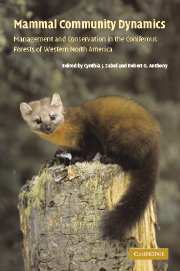 Mammal Community Dynamics
Mammal Community Dynamics Published online by Cambridge University Press: 15 December 2009
Introduction
Wild ungulates play important roles in coniferous forest throughout western North America. Their biology is well known compared with that of other species of wildlife. They have sufficiently large home ranges to integrate spatial patterns across landscapes. Finally, they are often migratory (Wallmo 1981, Nicholson et al. 1997). Their life-history characteristics require consideration of entire landscapes rather than isolated patches of habitat for purposes of conservation and management (Hanley 1996, Kie et al. 2002). Ungulates require temporally and spatially diverse habitat components such as food and cover. These mammals can have significant effects on vegetation composition and basic ecosystem processes such as nutrient cycling, thereby acting as keystone species (Molvar et al. 1993, Wallis de Vries 1995, Hanley 1996, Hobbs 1996, Nicholson et al. 1997, Simberloff 1998, Kie et al. 2002).
Ungulates have economic value to society as well. Most species provide recreational hunting opportunities and also can have non-consumptive, aesthetic values (Loomis et al. 1989). Conversely, ungulates can cause damage to gardens and other landscaping (Conover 1997), to agricultural crops, (Austin and Urness 1993), and to new tree seedlings (Bandy and Taber 1974). Damage from deer–vehicle collisions also can be substantial (Romin and Bissonette 1996).
Four species of ungulates, all members of the family Cervidae, commonly occur in coniferous forests in western North America: elk (Cervus elaphus), moose (Alces alces), mule and black-tailed deer (Odocoileus hemionus), and white-tailed deer (Odocoileus virginianus).
To save this book to your Kindle, first ensure [email protected] is added to your Approved Personal Document E-mail List under your Personal Document Settings on the Manage Your Content and Devices page of your Amazon account. Then enter the ‘name’ part of your Kindle email address below. Find out more about saving to your Kindle.
Note you can select to save to either the @free.kindle.com or @kindle.com variations. ‘@free.kindle.com’ emails are free but can only be saved to your device when it is connected to wi-fi. ‘@kindle.com’ emails can be delivered even when you are not connected to wi-fi, but note that service fees apply.
Find out more about the Kindle Personal Document Service.
To save content items to your account, please confirm that you agree to abide by our usage policies. If this is the first time you use this feature, you will be asked to authorise Cambridge Core to connect with your account. Find out more about saving content to Dropbox.
To save content items to your account, please confirm that you agree to abide by our usage policies. If this is the first time you use this feature, you will be asked to authorise Cambridge Core to connect with your account. Find out more about saving content to Google Drive.